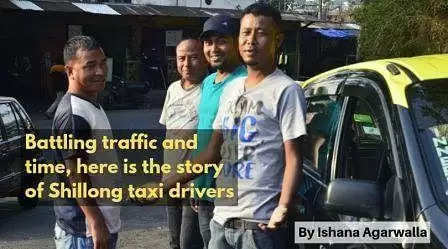Meghalaya: Battling traffic and time, here is the story of Shillong taxi drivers

by Ishana Agarwalla | May 19, 2019
Meghalaya's capital town Shillong has a quaint concept of 'shared taxi' system which has caught on because it is easy on the commuter's pocket. However, there is an obvious downside to this economically happy arrangement – each time one hops into a shared taxi here in Shillong one is put in a rather strange position as the passengers are huddled up in the back seat waiting to jump right off. While ones journey may have taken a mere 20 minutes, the driver spends his entire day driving from one end of the city to another', day in and day out, sometimes with two passengers cramped next to him.

ALSO READ:
A typical Shillong cabbie's day starts off early in the morning either waiting for passengers at usual taxi stands or being called out by passengers who are eagerly waiting on the side of the road. What ever it may be, their journey begins from one locality to another, negotiating through the traffic and trying to make it on time so that their passengers have a comparatively safe trip.
If the discomfort of the taxis overcrowded state, the long wait at traffic snarls, the uncomfortable rides on broken roads irk the passengers, can one imagine the plight of the drivers who have to endure this all day , day after day, years on end?
CHALLENGES FACED BY SHILLONG TAXI DRIVERS
Let us take a look at the difficulties and challenges faced by Shillong taxi drivers. The various kinds of passengers they have to deal with, problems they may face when they drive at unsafe hours in routes which they are not familiar with and their views on their lot.
Most of the taxi drivers start driving for a living at a very young age due to unemployment and financial issues sometimes with or without a driver's licence or proper paperwork.
ALSO READ:
Gary James who was one among a very helpful group of taxi drivers we interviewed in Boyce Road, Shillong, told us that he was only 22 years old when he first started driving and has been doing so for the past 15 years.

There were various queries which we had about how they managed to work around the clock and what kind of routes they took . They answered very confidently that they were familiar with almost ever inch of the town. The different localities and odd hours did not matter as they found it safe to drive at any time. Though this depended on the passengers. Most of the drivers that were interviewed were ones who picked and dropped children to and from school .They chose routes which were safe for the children so as to get them home from school safe and on time.
To ensure a safe mode of transportation for women, the government had started a different concept of public transportation a few years back — The Pink and green taxis which were seen commuting in the year 2011. The pink taxis were meant for female commuters in the urban areas and the green ones for rural areas but there were no takers. In a span of just a few months, there were only about two-three women who started driving these cabs with the pink stripe. However, this rule was soon broken as male drivers were seen driving these cabs. According to the information we gathered during the interview, there were no women who came forward for this job and hence men took over turning this entire concept into a futile one.
With the increase in the population of both private vehicles and public transport such as the buses, the taxi drivers are having a very difficult time. Another problem that they face is the renewal of their permits.
The senior drivers state that as the new wave of young drivers have emerged it has become very difficult for them to drive or find passengers – the younger, lesser experienced drivers are reckless and aggressive and most of the time do not have a valid licence. They have requested the authorities to take action and clear out those drivers who pose a threat to the people.
When asked if the new two wheeler taxisystem hampered their business, a few seemed not to have heard of it and therest were not sure as no change was seen in their business and they wanted towait for a few months before making a statement.
If looked at objectively, the cabbies in Shillong do not have much going for them. For most of them it is a job that keeps them from being completely unemployed.
Its is important to note here that many of them do not own the cab they drive .They do not have a regular salary but have an arrangement with the car owners where they pay them a fixed amount every day and keep the extra earnings for themselves. Little should we wonder then why they are in a tearing hurry to complete their trips. The same could be the reason for stuffing their tiny cabs more tightly than a sardine can!!
In addition , there is a perpetual clash of interest between the public who demand a reduction in the fares while the cabbies fight for a raise.
At the end of the day, a Shillong cabbie has as many responsibilities as we do. His struggle may be lessened one evening but emerges anew the next morning. Each day brings him face to face with the unexpected!
ABOUT THE WRITER: Ishaana Agarwalla is a student of Christ University, Bengaluru and is currently an intern with TNT- The Northeast Today. She holds a passion for photography and Art. She can be reached at ishana.agarwalla@arts.christuniversity.in

















